Xubin Li
Mem-PAL: Towards Memory-based Personalized Dialogue Assistants for Long-term User-Agent Interaction
Nov 17, 2025Abstract:With the rise of smart personal devices, service-oriented human-agent interactions have become increasingly prevalent. This trend highlights the need for personalized dialogue assistants that can understand user-specific traits to accurately interpret requirements and tailor responses to individual preferences. However, existing approaches often overlook the complexities of long-term interactions and fail to capture users' subjective characteristics. To address these gaps, we present PAL-Bench, a new benchmark designed to evaluate the personalization capabilities of service-oriented assistants in long-term user-agent interactions. In the absence of available real-world data, we develop a multi-step LLM-based synthesis pipeline, which is further verified and refined by human annotators. This process yields PAL-Set, the first Chinese dataset comprising multi-session user logs and dialogue histories, which serves as the foundation for PAL-Bench. Furthermore, to improve personalized service-oriented interactions, we propose H$^2$Memory, a hierarchical and heterogeneous memory framework that incorporates retrieval-augmented generation to improve personalized response generation. Comprehensive experiments on both our PAL-Bench and an external dataset demonstrate the effectiveness of the proposed memory framework.
CTR-Driven Ad Text Generation via Online Feedback Preference Optimization
Jul 27, 2025Abstract:Advertising text plays a critical role in determining click-through rates (CTR) in online advertising. Large Language Models (LLMs) offer significant efficiency advantages over manual ad text creation. However, LLM-generated ad texts do not guarantee higher CTR performance compared to human-crafted texts, revealing a gap between generation quality and online performance of ad texts. In this work, we propose a novel ad text generation method which optimizes for CTR through preference optimization from online feedback. Our approach adopts an innovative two-stage framework: (1) diverse ad text sampling via one-shot in-context learning, using retrieval-augmented generation (RAG) to provide exemplars with chain-of-thought (CoT) reasoning; (2) CTR-driven preference optimization from online feedback, which weighs preference pairs according to their CTR gains and confidence levels. Through our method, the resulting model enables end-to-end generation of high-CTR ad texts. Extensive experiments have demonstrated the effectiveness of our method in both offline and online metrics. Notably, we have applied our method on a large-scale online shopping platform and achieved significant CTR improvements, showcasing its strong applicability and effectiveness in advertising systems.
Differentiable Solver Search for Fast Diffusion Sampling
May 27, 2025Abstract:Diffusion models have demonstrated remarkable generation quality but at the cost of numerous function evaluations. Recently, advanced ODE-based solvers have been developed to mitigate the substantial computational demands of reverse-diffusion solving under limited sampling steps. However, these solvers, heavily inspired by Adams-like multistep methods, rely solely on t-related Lagrange interpolation. We show that t-related Lagrange interpolation is suboptimal for diffusion model and reveal a compact search space comprised of time steps and solver coefficients. Building on our analysis, we propose a novel differentiable solver search algorithm to identify more optimal solver. Equipped with the searched solver, rectified-flow models, e.g., SiT-XL/2 and FlowDCN-XL/2, achieve FID scores of 2.40 and 2.35, respectively, on ImageNet256 with only 10 steps. Meanwhile, DDPM model, DiT-XL/2, reaches a FID score of 2.33 with only 10 steps. Notably, our searched solver outperforms traditional solvers by a significant margin. Moreover, our searched solver demonstrates generality across various model architectures, resolutions, and model sizes.
DMM: Building a Versatile Image Generation Model via Distillation-Based Model Merging
Apr 16, 2025Abstract:The success of text-to-image (T2I) generation models has spurred a proliferation of numerous model checkpoints fine-tuned from the same base model on various specialized datasets. This overwhelming specialized model production introduces new challenges for high parameter redundancy and huge storage cost, thereby necessitating the development of effective methods to consolidate and unify the capabilities of diverse powerful models into a single one. A common practice in model merging adopts static linear interpolation in the parameter space to achieve the goal of style mixing. However, it neglects the features of T2I generation task that numerous distinct models cover sundry styles which may lead to incompatibility and confusion in the merged model. To address this issue, we introduce a style-promptable image generation pipeline which can accurately generate arbitrary-style images under the control of style vectors. Based on this design, we propose the score distillation based model merging paradigm (DMM), compressing multiple models into a single versatile T2I model. Moreover, we rethink and reformulate the model merging task in the context of T2I generation, by presenting new merging goals and evaluation protocols. Our experiments demonstrate that DMM can compactly reorganize the knowledge from multiple teacher models and achieve controllable arbitrary-style generation.
SceneBooth: Diffusion-based Framework for Subject-preserved Text-to-Image Generation
Jan 07, 2025



Abstract:Due to the demand for personalizing image generation, subject-driven text-to-image generation method, which creates novel renditions of an input subject based on text prompts, has received growing research interest. Existing methods often learn subject representation and incorporate it into the prompt embedding to guide image generation, but they struggle with preserving subject fidelity. To solve this issue, this paper approaches a novel framework named SceneBooth for subject-preserved text-to-image generation, which consumes inputs of a subject image, object phrases and text prompts. Instead of learning the subject representation and generating a subject, our SceneBooth fixes the given subject image and generates its background image guided by the text prompts. To this end, our SceneBooth introduces two key components, i.e., a multimodal layout generation module and a background painting module. The former determines the position and scale of the subject by generating appropriate scene layouts that align with text captions, object phrases, and subject visual information. The latter integrates two adapters (ControlNet and Gated Self-Attention) into the latent diffusion model to generate a background that harmonizes with the subject guided by scene layouts and text descriptions. In this manner, our SceneBooth ensures accurate preservation of the subject's appearance in the output. Quantitative and qualitative experimental results demonstrate that SceneBooth significantly outperforms baseline methods in terms of subject preservation, image harmonization and overall quality.
FlowDCN: Exploring DCN-like Architectures for Fast Image Generation with Arbitrary Resolution
Oct 30, 2024


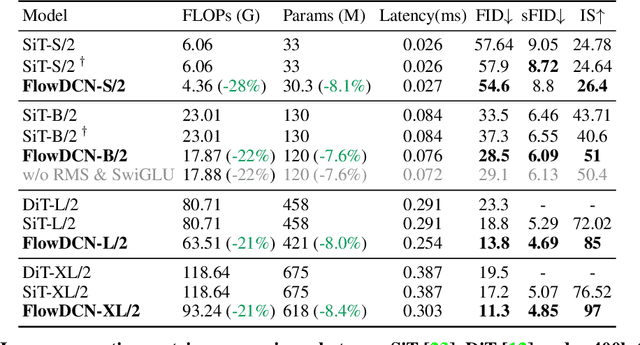
Abstract:Arbitrary-resolution image generation still remains a challenging task in AIGC, as it requires handling varying resolutions and aspect ratios while maintaining high visual quality. Existing transformer-based diffusion methods suffer from quadratic computation cost and limited resolution extrapolation capabilities, making them less effective for this task. In this paper, we propose FlowDCN, a purely convolution-based generative model with linear time and memory complexity, that can efficiently generate high-quality images at arbitrary resolutions. Equipped with a new design of learnable group-wise deformable convolution block, our FlowDCN yields higher flexibility and capability to handle different resolutions with a single model. FlowDCN achieves the state-of-the-art 4.30 sFID on $256\times256$ ImageNet Benchmark and comparable resolution extrapolation results, surpassing transformer-based counterparts in terms of convergence speed (only $\frac{1}{5}$ images), visual quality, parameters ($8\%$ reduction) and FLOPs ($20\%$ reduction). We believe FlowDCN offers a promising solution to scalable and flexible image synthesis.
Enhancing Prompt Following with Visual Control Through Training-Free Mask-Guided Diffusion
Apr 23, 2024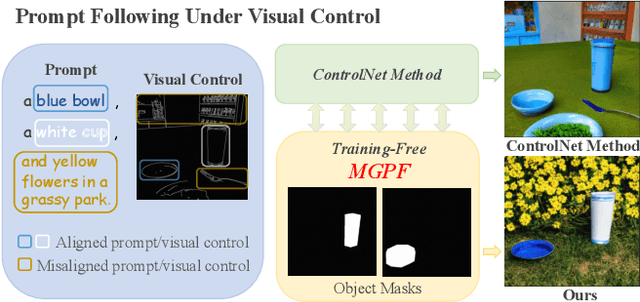

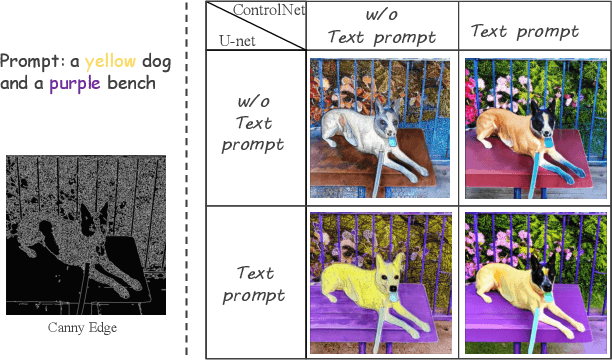
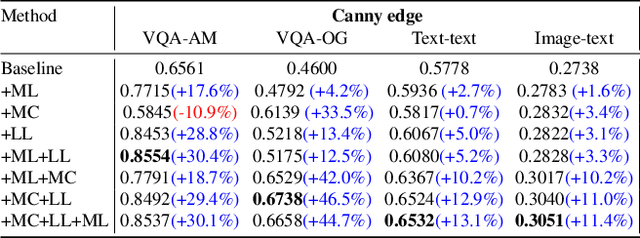
Abstract:Recently, integrating visual controls into text-to-image~(T2I) models, such as ControlNet method, has received significant attention for finer control capabilities. While various training-free methods make efforts to enhance prompt following in T2I models, the issue with visual control is still rarely studied, especially in the scenario that visual controls are misaligned with text prompts. In this paper, we address the challenge of ``Prompt Following With Visual Control" and propose a training-free approach named Mask-guided Prompt Following (MGPF). Object masks are introduced to distinct aligned and misaligned parts of visual controls and prompts. Meanwhile, a network, dubbed as Masked ControlNet, is designed to utilize these object masks for object generation in the misaligned visual control region. Further, to improve attribute matching, a simple yet efficient loss is designed to align the attention maps of attributes with object regions constrained by ControlNet and object masks. The efficacy and superiority of MGPF are validated through comprehensive quantitative and qualitative experiments.
Accelerating Image Generation with Sub-path Linear Approximation Model
Apr 23, 2024

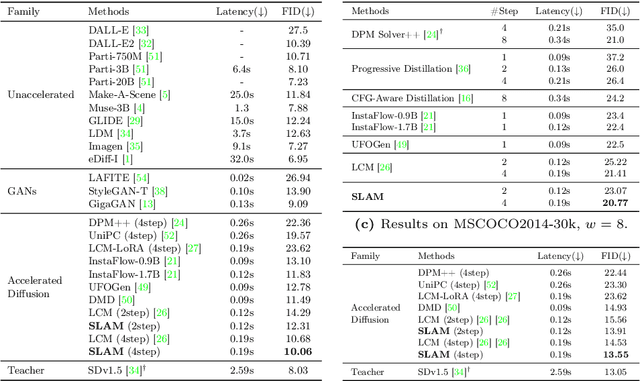

Abstract:Diffusion models have significantly advanced the state of the art in image, audio, and video generation tasks. However, their applications in practical scenarios are hindered by slow inference speed. Drawing inspiration from the approximation strategies utilized in consistency models, we propose the Sub-path Linear Approximation Model (SLAM), which accelerates diffusion models while maintaining high-quality image generation. SLAM treats the PF-ODE trajectory as a series of PF-ODE sub-paths divided by sampled points, and harnesses sub-path linear (SL) ODEs to form a progressive and continuous error estimation along each individual PF-ODE sub-path. The optimization on such SL-ODEs allows SLAM to construct denoising mappings with smaller cumulative approximated errors. An efficient distillation method is also developed to facilitate the incorporation of more advanced diffusion models, such as latent diffusion models. Our extensive experimental results demonstrate that SLAM achieves an efficient training regimen, requiring only 6 A100 GPU days to produce a high-quality generative model capable of 2 to 4-step generation with high performance. Comprehensive evaluations on LAION, MS COCO 2014, and MS COCO 2017 datasets also illustrate that SLAM surpasses existing acceleration methods in few-step generation tasks, achieving state-of-the-art performance both on FID and the quality of the generated images.
RHanDS: Refining Malformed Hands for Generated Images with Decoupled Structure and Style Guidance
Apr 22, 2024



Abstract:Although diffusion models can generate high-quality human images, their applications are limited by the instability in generating hands with correct structures. Some previous works mitigate the problem by considering hand structure yet struggle to maintain style consistency between refined malformed hands and other image regions. In this paper, we aim to solve the problem of inconsistency regarding hand structure and style. We propose a conditional diffusion-based framework RHanDS to refine the hand region with the help of decoupled structure and style guidance. Specifically, the structure guidance is the hand mesh reconstructed from the malformed hand, serving to correct the hand structure. The style guidance is a hand image, e.g., the malformed hand itself, and is employed to furnish the style reference for hand refining. In order to suppress the structure leakage when referencing hand style and effectively utilize hand data to improve the capability of the model, we build a multi-style hand dataset and introduce a twostage training strategy. In the first stage, we use paired hand images for training to generate hands with the same style as the reference. In the second stage, various hand images generated based on the human mesh are used for training to enable the model to gain control over the hand structure. We evaluate our method and counterparts on the test dataset of the proposed multi-style hand dataset. The experimental results show that RHanDS can effectively refine hands structure- and style- correctly compared with previous methods. The codes and datasets will be available soon.
Long Short-Term Planning for Conversational Recommendation Systems
Oct 23, 2023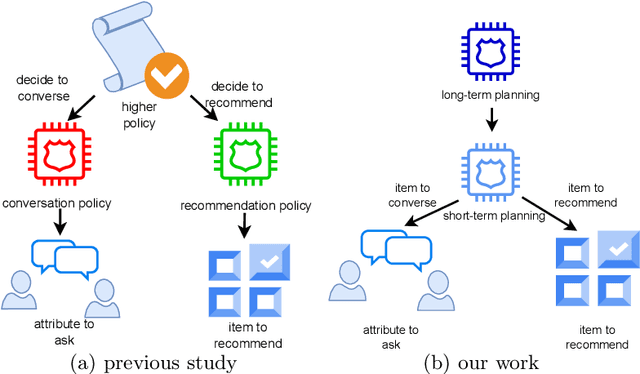

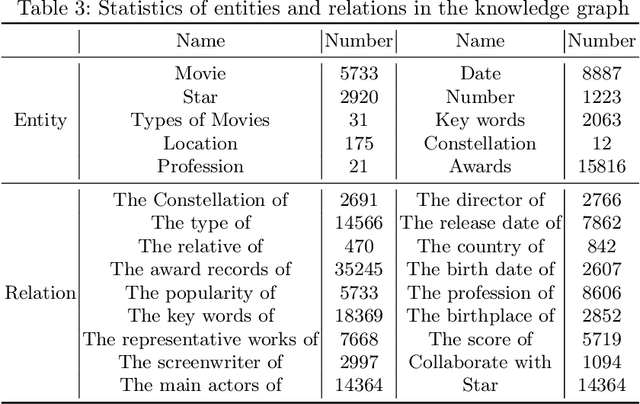
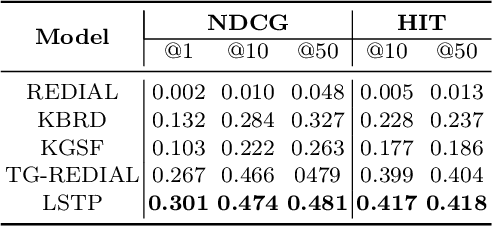
Abstract:In Conversational Recommendation Systems (CRS), the central question is how the conversational agent can naturally ask for user preferences and provide suitable recommendations. Existing works mainly follow the hierarchical architecture, where a higher policy decides whether to invoke the conversation module (to ask questions) or the recommendation module (to make recommendations). This architecture prevents these two components from fully interacting with each other. In contrast, this paper proposes a novel architecture, the long short-term feedback architecture, to connect these two essential components in CRS. Specifically, the recommendation predicts the long-term recommendation target based on the conversational context and the user history. Driven by the targeted recommendation, the conversational model predicts the next topic or attribute to verify if the user preference matches the target. The balance feedback loop continues until the short-term planner output matches the long-term planner output, that is when the system should make the recommendation.
 Add to Chrome
Add to Chrome Add to Firefox
Add to Firefox Add to Edge
Add to Edge